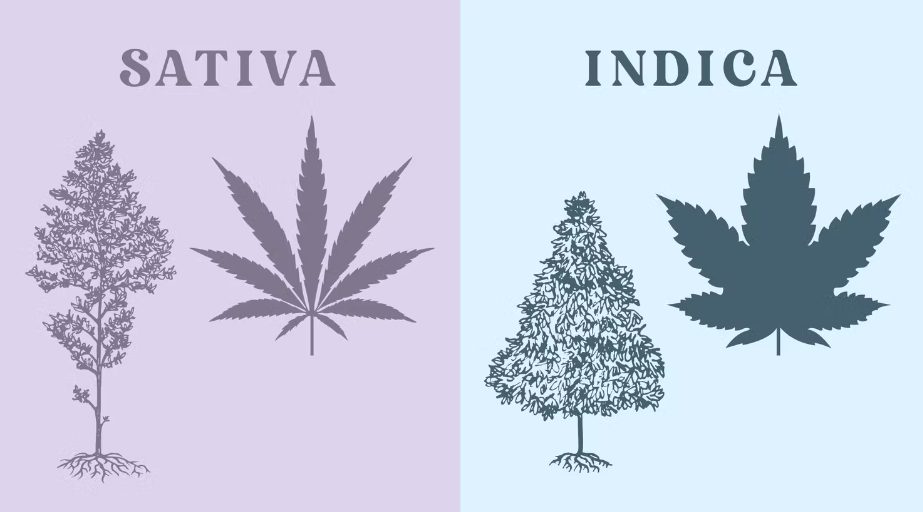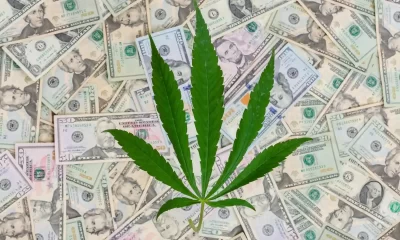Blogs
Indica vs. sativa: understanding the differences between weed types

When browsing cannabis strains or purchasing cannabis at a dispensary, you’ll notice that strains are commonly broken up into three groups: indica, sativa, and hybrid. Most consumers and budtenders use these weed types to predict effects, but are they accurate?
Science is pointing to a better way of determining the effects a cannabis strain will have on you: cannabinoids and terpenes, the compounds that make up a particular strain’s chemical profile.
So why do smokers and budtenders alike still use indica, sativa, and hybrid instead of the cannabinoid and terpene model?
There’s a big push in the cannabis industry to disavow the indica/sativa/hybrid classification system because it is not based in data and science—the terms are botanical names that refer to a plant’s structure, not the effects it produces.
However, most of the cannabis industry, including shops where you buy weed, is still stuck in classifying strains as either indicas, sativas, or hybrids for one main reason: It’s easy. Give a consumer three options—up, down, or in-between—and you can easily explain how a certain strain will make them feel and sell a product. Like it or not, the indica, sativa, hybrid classification system is still entrenched in the world.
Both models have value, and consumers of all levels can use both. For an easier, more general way to pick a weed strain and its effects, the indica/sativa/hybrid model may work for you. Once comfortable with cannabis, you may want to dig into the nuances of weed a bit more, and learn about chemical profiles, cannabinoids, and terpenes—our preferred method.
Let’s look at the differences between indicas and sativas, and the usefulness of the two classification systems.
Indica vs. sativa: understanding the basics
The common understanding of indicas and sativas is that indica strains are physically sedating, perfect for relaxing with a movie or as a nightcap before bed, and sativa strains are energizing with uplifting cerebral effects that pair well with physical activity, social gatherings, and creative projects. Hybrid strains are thought to have a mix of indica and sativa effects.
But indica doesn’t always mean “in da couch” and sativas don’t necessarily energize all consumers. The origins of the two terms are actually rooted in botany, not effects, and describe the physical structure of a plant. On top of that, every person has a different body chemistry, so a strain can affect each person differently.
However, even today, the belief that indicas, sativas, and hybrids deliver distinct effects is still deeply rooted in mainstream cannabis culture. If you’ve ever been to a dispensary, you’ve likely heard a budtender begin a strain recommendation by asking which of those three types you prefer, but the science doesn’t support that.
The origin of indica and sativa
In 1753, Carl Linnaeus published Species Plantarum, classifying all cannabis plants under one group, “Cannabis sativa L.,” with “Cannabis” as the genus, “sativa” as the species, and “L.” indicating Linnaeus’ system. “Sativa” comes from the Latin “sativum,” meaning “cultivated.”
French biologist Jean-Baptiste Lamarck updated the naming in 1785 with two distinct species: “Cannabis sativa,” a taller, lankier, and more fibrous plant, and “Cannabis indica,” a shorter, stouter, and more psychoactive plant, its name meaning “from India,” where it was thought to originate.
These definitions largely refer to each weed type’s physical structure and are still used today.
Sativas
Typically thought to be energizing, sativas originally grew in warm, humid climates, growing long and lanky so they can dry out and not absorb so much humidity. Their warm climate also means they can take a long time to grow and flower, or produce buds, because the weather won’t get cold and rainy at the end of the growing season.
Indicas
Typically said to be relaxing, indicas originally grew in cold, northern climates. They grew short and dense because of their environment, and their growing life cycle is shorter so they can get harvested before the cold and wet of fall and winter set in.
Hemp
As a side note, what we call “hemp” refers to the industrial, non-intoxicating varieties of cannabis harvested primarily for fiber, seeds, CBD, and novel cannabinoids such as delta-8. Hemp’s fiber can be used to make materials and textiles, its seeds can be eaten, and CBD and other novel cannabinoids can be extracted from it. Legally, hemp is any cannabis plant with less than 0.3% THC.
Indica, sativa, and hybrid vs. cannabinoids and terpenes
Weed is incredibly nuanced. Each strain has its own chemical profile that will interact differently with each person’s body chemistry—the same strain could affect you and your smoking buddy completely differently.
As weed nerds here at Leafly, we prefer the more complex and specific model of determining a strain’s effects by looking at its mix of cannabinoids and terpenes (more below). But the indica/sativa/hybrid model is a basic, quick and easy way to get a general sense of how a strain will hit you. Just know that it isn’t exact.
Leafly’s own strain database uses the cannabinoid and terpene model, compiling the chemical profiles of thousands of strains using data from cannabis testing labs all over the country.
This method is a little more complex, but don’t let data scare you—once you find a strain you like, you can dial in your cannabis experience and find a strain that’s best for you.
How to use the indica, sativa, hybrid method
Had a long day and want to chill out? Need to do some spring cleaning or get a project done? Talking to your local budtender, they will tell you:
- Indicas are calm and relaxing, great for chilling out at the end of the night, watching a movie or listening to music, taking a nap, or just staring at the wall.
- Sativas are energetic and will make you productive. They’re great for physical activity, going for a hike, completing a task, cleaning, and anything that requires focus.
- Hybrid strains offer a mix of indica- and sativa-like effects.
Broadly speaking, you’ll see a lot of consistency to the idea that indicas are relaxing and sativas are energetic in Leafly’s own Top 100 cannabis strains: Most of the strains in the “sleepy” and “relaxed” categories are indicas, while most of the “energetic” strains are sativas.
Easy, right? Now let’s dial in that process.
Cannabinoids and terpenes
So if indica and sativa aren’t the best predictors of effects, what are?
The better way to pinpoint effects of different weed strains is to talk about their mix of cannabinoids and terpenes, or the chemical compounds in it. These compounds combine to create the entourage effect, leading to the feeling of being high.
What are cannabinoids?
The cannabis plant is composed of hundreds of chemical compounds that create unique effects, and the primary ones are cannabinoids. THC and CBD are the two most common cannabinoids and are the main drivers of cannabis’ therapeutic and recreational effects.
- THC (delta-9-tetrahydrocannabinol) is the compound that most think of when talking about weed—it’s what makes you feel high, and relieves symptoms like pain and nausea.
- CBD (cannabidiol) is a non-intoxicating compound known to alleviate anxiety, pain, inflammation, and many other medical ailments.
What are terpenes?
If you’ve ever used aromatherapy to relax or invigorate your mind and body, you understand the basics of terpenes, the aromatic compounds commonly produced by plants and fruit. They can be found in lavender flowers, oranges, hops, pepper, and of course, cannabis. Secreted by the same glands that ooze THC and CBD, terpenes are what make cannabis smell like berries, citrus, pine, fuel, etc.
There are many types of terpenes found in cannabis, but these four are the most common:
One question yet to be answered by research is how terpenes—and different combinations of terpenes—shape the effects of different cannabis strains. So while cannabinoids are the primary step in determining how a strain will make you feel, for example, whether you want THC or CBD in a strain, or both, terpenes add a lot to effects as well.
How to use the cannabinoid and terpene method
When choosing a cannabis strain, instead of thinking in terms of an indica or sativa, the better way is to think of weed is in terms of cannabinoids and terpenes, or a strain’s chemical profile (another name for this is “chemovars”).
Cannabis strains are broken down into three broad chemical profile types, or chemovars:
- Type I: high THC, low CBD
- Type II: balanced, or equal parts of THC and CBD (like 1:1 cannabis strains)
- Type III: high CBD, low THC
These terms are out there in the industry, but aren’t commonly used—you likely won’t hear a budtender using them, and most customers don’t walk into a weed shop asking for a “type II” strain; they’ll ask for a “balanced” or “1:1” strain.
Step 1: Pick a cannabinoid
To use the cannabinoid and terpene model to pick a strain, start by considering how much THC and CBD you want in your strain.
THC-dominant strains (Type I) are high THC/low CBD, and are great for people seeking a potent euphoric experience. These strains are also selected by patients treating pain, depression, anxiety, insomnia, and more.
Balanced THC/CBD strains, or 1:1 strains (Type II), contain similar levels of THC and CBD, offering mild euphoria alongside symptom relief. These strains tend to be a good choice for novice consumers seeking an introduction to cannabis’ signature high.
CBD-dominant strains (Type III) are high CBD/low THC, and are widely used by those highly sensitive to THC or patients needing clear-headed symptom relief because of their low levels of THC. If you tend to feel anxious with THC-dominant strains or dislike other side affects associated with THC, try a strain with high levels of CBD.
Step 2: Pick some terpenes
Take note of the terpenes in some of your favorite strains. You can find a strain’s terpene profile in Leafly’s strain database, and many products include this information as well.
For example, GSC is primarily composed of caryophyllene, with smaller amounts of myrcene, and limonene. If you like GSC, you may like strains with that similar mix of terpenes, such as GMO Cookies or OG Kush. Conversely, if you find a strain you don’t like, it’s highly likely you won’t like strains with that similar terpene profile.
Step 3: Use Leafly’s strain database
As previously mentioned, Leafly’s own strain database is based on the cannabinoid and terpene model. It’s the more accurate of the two models because it relies on data from cannabis testing labs.
Weed has to be tested before it can be sold in a dispensary, ostensibly for pesticides and contaminants, but sometimes also for its cannabinoid and terpene levels. Leafly uses that data to power our strain database and strain search tool, giving consumers a variety of related strains to choose from and explore once they find a strain they like.
More considerations when choosing between indicas and sativas
Other factors play into how a strain will affect you. Consider the following when looking for a cannabis strain or product.
Tolerance
Everyday smokers will have a much higher tolerance than occasional smokers and can often consume a lot more weed, or stronger weed, without feeling effects. If you don’t smoke a lot, remember the saying: “start low, go slow.”
Dosage
A strain’s potency and how much you consume, known as dosage, will greatly affect a cannabis experience.
Many popular strains at dispensaries can be potent, and a strain packing 25% THC might not be as enjoyable as one with 16% THC. There’s no shame in opting for a low THC percentage—find the right level for you and your ideal experience.
Additionally, taking a couple puffs and smoking an entire joint will produce much different effects, and a different intensity of effects. If your tolerance is low, consider a low-THC strain in low doses.
Body chemistry
Everyone’s body chemistry is different, and it’s hard to know how a strain will affect each individual. Even if you consume as frequently as someone else, your bodies could react to cannabis much differently. A friend may be able to burn down a whole joint, but maybe a puff or two are sufficient for you.
If you’re susceptible to anxiety or other negative side effects of THC, try a strain high in CBD.
Set and setting
Aside from tolerance, dosage, and body chemistry, your mindset and environment when consuming weed—known as set and setting—are crucial to enjoying cannabis. If you’re having a bad day or are nervous about trying weed, consuming it may give you negative effects. Additionally, if you’re not a social person, smoking in a big crowd may also give you negative feelings.
Set and setting depend entirely on the individual. Some people thrive in social settings, some don’t. Some prefer smoking in the comfort of their home, while others enjoy consuming out in nature.
Consumption method
How you consume weed will also determine how a strain affects you. One puff on a vape is generally thought to be lighter and deliver less effects than one puff of a joint. Doing dabs will produce intense effects immediately, and generally isn’t for beginners.
If you want long-lasting effects, consider edibles, and again, start low, and go slow.
Medical history
Be mindful of any medical conditions you have, or if you are taking any medication, and how they might interact with cannabis. When in doubt, talk to your doctor or a medical professional before trying cannabis. They may have suggestions or recommendations for you to complement your existing medical or health regimen.
Desired effect, mood, or experience
If you’re hoping for a specific experience, like relaxing or watching a movie, or if you’re looking to treat an ailment like insomnia or nausea, use Leafly’s strain lists to help select a strain, or ask your local budtender for recommendations on what you’re looking for.
Remember that not all indicas are sleepy or heavy, and not all sativas are energetic or uplifting.
Note favorite and least favorite strains
Keep track of what weed strains you like and don’t like to explore (or avoid) similar strains. If you like a strain with a certain cannabinoid level and terpene profile, you’ll likely enjoy another strain with similar levels.
Additionally, strains in the same family, or with the same lineage, often have similar chemical profiles—GSC is derived from OG Kush, and is parent to GMO Cookies, Sherbert, and many more, so they’ll all have similar terpenes.
Summary of sativas, indicas, and hybrids
What is a sativa?
While not all sativa marijuana strains will energize you, most consumers notice a tendency for sativas to produce a “head high,” an uplifting, stimulating effect. They also often report sativas as being helpful in mitigating stress or anxiety, and many consumers enjoy sativas to sharpen focus and boost creativity or motivation.
Sativa effects
Common effects associated with sativa strains include feeling happy, uplifting, euphoric, and energetic. Sativas are often thought of as “daytime” strains, used for feeling productive, creative, and focused, and for getting chores done.
Popular sativa strains
There are many sativa strains to try, and you’ve likely heard of some of the most popular. Most dispensaries should stock at least some of these sativa weed strains as they’re generally a crowd favorite.
What is an indica?
Not all indica strains will put you “in da couch,” but nevertheless, many consumers associate indicas with body effects, for example, heavy limbs or a tingly face. They also report indicas are helpful in aiding relaxation and curbing insomnia.
Indica effects
Common effects associated with indica strains include feeling relaxed, euphoric, happy, and sleepy. Indicas are commonly known as nighttime strains, used for relaxing and unwinding at the end of the night.
Popular indica strains
There are many indica strains, many of which you may be familiar with. Check your local dispensary for these popular indica weed strains.
What are hybrid strains?
Hybrid strains are bred from both indica- and sativa-descended plants. Due to the long history of crossbreeding cannabis, strains that have pure indica or pure sativa lineages are rare. Most strains referred to as “indica” or “sativa” are, in fact, hybrids, with genetics inherited from both types.
Hybrid effects
Since hybrid weed strains derive genetics from both indicas and sativas, their effects pull from both indica and sativa strains. Common effects include feeling happy, euphoric, uplifting, energetic, relaxing—it all depends on which hybrid you consume and what effects its parent strains produce.
Looking at a hybrid’s lineage—its parent strains—may give you a better sense of what kind of effects it will produce. For example, if it has more indica in its lineage, it might have effects more associated with those strains, but this is not always the case.
Popular hybrid strains
There’s certainly no shortage of hybrid strains on the market, and some of the most popular you’ll come across are also the most iconic.
Popular strains by strain type and effect
| Strain Name | Strain Type | THC | CBD | Helps with |
|---|---|---|---|---|
| Sour Diesel | sativa | 18% | less than 1% | creativity, depression, anxiety |
| Green Crack | sativa | 17% | less than 1% | energy, stress, euphoria |
| Lemon Haze | sativa | 18% | less than 1% | happiness, fatigue, pain |
| Charlotte’s Web | sativa | less than 1% | 13% | pain, stress, anxiety |
| Candyland | sativa | 18% | less than 1% | socializing, relaxation, energy |
| Purple Punch | indica | 19% | less than 1% | relaxation, stress, euphoria |
| Pennywise | indica | 8% | 8% | relaxation, anxiety, pain |
| Northern Lights | indica | 16% | less than 1% | stress, pain, anxiety |
| GMO Cookies | indica | 25% | less than 1% | pain, insomnia, relaxation |
| Bubba Kush | indica | 17% | less than 1% | appetite, pain, insomnia |
| GG4 | hybrid | 20% | less than 1% | relaxation, happiness, stress |
| Sour Tsunami | hybrid | less than 1% | 12% | pain, stress, anxiety |
| Sherbert | hybrid | 18% | less than 1% | happiness, creativity, relaxation |
| Cannatonic | hybrid | 5% | 10% | pain, focus, stress |
| Blue Dream | hybrid | 18% | less than 1% | relaxation, euphoria, happiness |
Indica vs. sativa FAQs
Here are answers to some common questions about indica and sativa marijuana.
Is there a difference between indicas and sativas?
“Indica” and “sativa” are botanical terms referring to a plant’s physical structure. As far as effects, indicas are thought to be sedating and relaxing, while sativas are thought to be uplifting and energetic.
Do sativas give you energy?
While there is no scientific evidence that sativas give you energy, they are believed to be uplifting and euphoric.
Do sativas give you a body high?
Sativas are commonly thought to provide a head and body high, although every consumer’s body chemistry is different.
Do sativas give you the munchies?
Sativa strains may help stimulate appetite and give you the munchies, but it depends on your body chemistry.
Will sativas keep you up at night?
Sativas are thought to be energizing so they may keep you up at night, but it depends on your body chemistry.
Do indicas make you sleepy?
In general, indicas are thought to be relaxing, which can make you feel sleepy.
Do indicas give you a body high?
Some indica strains are known for delivering heavy body highs.
Will indicas make me feel paranoid?
If you’re prone to anxiety or paranoia when sober, indica or sativa strains may cause negative effects, but it depends on your body chemistry.
Will indicas turn my eyes red?
Indicas or sativas may make your eyes turn red, depending on your body.
Medical references
- Scholler DJ, et. al. Use patterns, beliefs, experiences, and behavioral economic demand of indica and sativa cannabis: A cross-sectional survey of cannabis users. Exp Clin Psychopharmacol, 2021. https://pubmed.ncbi.nlm.nih.gov/33856822/
- Clarke RC, Merlin MD. Cannabis Evolution and Ethnobotany. UC Press, 2013. https://www.researchgate.net/publication/275175754_Cannabis_Evolution_and_Ethnobotany
- Russo, EB. Taming THC: potential cannabis synergy and phytocannabinoid-terpenoid entourage effects. Br J Pharmacol, 2011. https://pubmed.ncbi.nlm.nih.gov/21749363/
- John M McPartland JM, Small E. A classification of endangered high-THC cannabis (Cannabis sativa subsp. indica) domesticates and their wild relatives. PhytoKeys, 2020. https://pubmed.ncbi.nlm.nih.gov/32296283/
This article was originally published September 20, 2018 and is often updated for accuracy and clarity.
Source: https://www.leafly.com/news/cannabis-101/sativa-indica-and-hybrid-differences-between-cannabis-types
Blogs
Border sales a boost for most marijuana retailers across US

Marijuana sales along state lines are key revenue generators for retail operators in the United States, and new insights suggest a similar business bump along international borders, particularly Mexico.
Data compiled by New York-based wholesale technology platform LeafLink – as well as information gathered from state agencies, quarterly reports and interviews with several cannabis companies – bear that out.
LeafLink analyzed hundreds of ZIP codes at the request of MJBizDaily and found strong links that when new recreational markets open, retailers near borders stock up on inventory significantly more than operators located elsewhere in a state.
Data from the past three years revealed wholesale marijuana products purchased by border stores jumped 140% after the launch of adult-use sales, while retailers located in more interior areas increased purchases by about 80%.
“The growth when a state launches adult-use sales at a border store in terms of purchasing activity is around double the growth of the remainder of the state,” LeafLink Strategy Analyst Ben Burstein told MJBizDaily.
Of course, numerous factors are at play – perhaps none more impactful than the marijuana policies of neighboring states.
That’s why Illinois retailers near Wisconsin, where marijuana possession is illegal, are still attracting Wisconsinites nearly four years after the launch of recreational sales.
There also are retail sales-tax implications, a big reason why St. Louis-areas operators are seeing an influx of shoppers from southern Illinois, where cannabis taxes are at least three times higher than in Missouri.
Meanwhile, border retail in New Mexico is boosting depressed economies along hundreds of miles of its shared borders, drawing stampedes of consumers from neighboring Texas and, more recently, cross-border buyers from Mexico.
Retail shakeup in the heartland
The February launch of adult-use sales in Missouri has caused ripple effects throughout the Midwest.
Missouri holds the rare distinction of bordering eight states, with only Illinois offering recreational marijuana sales.
Missouri’s 6% retail tax on recreational marijuana purchases is also among the lowest in the nation, drawing Illinois consumers across the Mississippi River in droves to buy much cheaper weed.
All in, cannabis sales taxes in neighboring Illinois eclipse 30%, second only to Washington state. And in Chicago, sales taxes can easily top 40%.
Demand is booming in western Missouri, too.
In April, Missouri retailers near the border of Kansas, where marijuana possession is also illegal, told MJBizDaily they were seeing foot traffic increase ninefold after expanding into recreational sales.
The rush of new customers, coupled with cultivation-capacity lags, has led to big spikes in wholesale flower prices and inventory shortages throughout the supply chain.
Retailers, for their part, are trying to keep pace.
To meet consumer demand, wholesale purchases per store in the Kansas City, Missouri, market increased from $97,000 in the quarter before the launch of recreational sales to $491,000 in the quarter after, a whopping 406% jump, according to LeafLink data.
In the St. Louis market, which borders southwestern Illinois, wholesale purchases per store increased nearly 57%, to $610,000, after adult-use sales began.
“The demand’s been bigger than anyone expected,” Burstein said.
A zero-sum game
In marijuana retail, particularly near state borders, it’s a zero-sum game.
The sales boom in the St. Louis market, which has more than 70 stores, has deflated business on the Illinois side of the border, where retailers have lost millions of dollars in sales since Missouri’s adult-use launch, according to quarterly reports and earnings calls.
Top executives at New York-based multistate operator Ascend Wellness Holdings, which has two shops near the Missouri border, cited revenue declines at its southern Illinois stores in recent earnings, saying it has led to suppressed margins that are expected to linger for much of the year.
Florida-based MSO Jushi Holdings, which also operates two Illinois stores near the Missouri border, reported an 8.8% year-over-year revenue decline to $66.4 million in its second quarter, partially attributing the slide to adult-use sales in Missouri.
In an Aug. 11 second-quarter earnings call, Jushi CEO James Cacioppo said total Illinois sales declined 20% from the first quarter and 40% year-over-year.
“I think we under-anticipated the pricing power initially out of the gate that retailers were going to have in Missouri,” Jushi Chief Strategy Director Trent Woloveck told MJBizDaily in an interview.
“The impact was a little bit greater than then we had thought due to that pricing for flower, vapes and infused products.”
In response, Jushi has implemented several initiatives, including adding new promotions and diversifying product SKUs (stock-keeping units) to ease the impact of declines sales in Illinois.
Northern exposure
Market dynamics in northern Illinois, particularly along the Wisconsin border, are a different story.
Wisconsin is among 10 states without a medical or recreational marijuana program.
Illinois counties bordering Wisconsin – including Lake, McHenry, Jo Daviess and Winnebago – accounted for 15.4%, or $239.7 million, of the nearly $1.6 billion in cannabis sales last year in the state, according to a fiscal analysis requested by pro marijuana-legalization lawmakers in Wisconsin.
The Wisconsin Legislative Fiscal Bureau report, which was released in March, cited annual statistics from the Illinois Department of Financial and Professional Regulation.
Moreover, the report estimated about 7.8% of marijuana sales in Illinois in 2022, roughly $36.1 million, were generated by out-of-state residents traveling from Wisconsin.
Under Illinois law, out-of-state residents can only purchase recreational cannabis.
Two of Chicago-based multistate operator Cresco Labs’ 10 stores in Illinois are located near the Wisconsin border: a Sunnyside outlet in South Beloit at the border and one in Rockford, about a 30-minute drive away.
The South Beloit store often draws up to 1,000 daily visitors, according to Cresco’s national retail president, Cory Rothschild – traffic on par with the nation’s busiest marijuana retailers in highly populated areas.
It’s all the more impressive, considering that South Beloit has a population of roughly 8,000 and is more than 40 miles from Madison, the nearest city and Wisconsin’s state capital.
“It’s an extremely high-volume retail location,” Rothschild told MJBizDaily.
“South Beloit and Rockford as well are probably (among the) top dispensaries in the country.”
Maryland
Maryland is the newest recreational cannabis market, with nearly 100 medical marijuana dispensaries having converted to adult-use retail in late June.
While LeafLink wholesale data suggests about a 10% increase in wholesale product purchases statewide after the launch of adult-use sales, some retailers along Maryland’s south and eastern borders are doubling orders to meet demand.
In Elkton, near the Delaware border, stores are ordering about $41,000 in wholesale products per month, up 115% since the launch of recreational sales on July 1.
In the Rockville/Germantown area – outside of Washington DC and near the Virginia and West Virginia borders – monthly wholesale purchases have increased about 42%, to $54,000 per store, since recreational sales began.
Though MMJ dispensaries opened in West Virginia in 2021, the state still has some of the harshest marijuana laws in the country, according to the Marijuana Policy Project.
Meanwhile, Virginia’s adult-use rollout has been put on ice by Republican Gov. Glenn Youngkin.
MSO MariMed’s wholesale business serving retailers in Maryland has benefited from increased demand from neighboring states, according to Jeff Jones, director of operations.
“We have retail customers that are very close to Virginia, Pennsylvania and West Virginia, and I’m sure that’s driving a significant amount of their business,” he said.
The Massachusetts-based company supplies every retailer in the state with its product brands.
MariMed is planning to double its cultivation and canopy space in Maryland, with product from that expansion expected to hit the wholesale and retail markets in the first quarter of 2024, Jones said.
Its retail operation in Annapolis – the state capital is about a 45-minute drive from Pennsylvania or West Virginia – hasn’t experienced the same type of uptick from border business but is still performing well, according to Jones.
A tale of two borders
The small town of Sunland Park, New Mexico, has racked up outsized sales since the state launched recreational retail in April 2022.
The sparsely populated bedroom community is situated across the border from El Paso, Texas, and Jaurez, Mexico, which have a combined population of more than 2.2 million.
That purchasing power has helped Sunland Park’s 88063 ZIP code top the state for per-capita adult-use spending, a sales metric that divides dollars spent for cannabis by population.
Per-person recreational marijuana spending in Sunland Park was $1,044, according to an MJBizDaily analysis of data from the New Mexico Regulation and Licensing Department.
Its 88063 ZIP code also houses two of New Mexico’s leading cannabis stores.
Ultra Health and Everest Cannabis Co. generated nearly $6.1 million in combined sales from August 2022 to February 2023, according to MJBizDaily research.
Because business has been so strong at that Sunland Park store, Ultra Health last summer opened an adjacent location that handles only online orders for pickups.
The majority of its 42 stores were strategically aligned to capture business along New Mexico’s more than 600-mile border with Texas, the second-most-populated state.
“I would say half our business is Texas-related,” Ultra Health CEO Duke Rodriguez told MJBizDaily.
As part of that strategy, the company is planning to open an outlet in Lordsburg with hopes of drawing customers from Mexico, Texas and Arizona.
Mexico border towns share more than commerce, including family, culture and language.
Some residents own commercial properties and homes on either side of the border.
And residents tend to travel freely between Juarez, El Paso and Sunland Park to shop, dine and visit friends and family, according to Rodriguez.
Many also buy regulated marijuana, which might come as a surprise to some industry watchers, especially those unfamiliar with border business in the Southwest.
Though transporting licensed cannabis across the U.S.-Mexico border is barred under federal law, it’s fairly common, industry insiders tell MJBizDaily.
“The product is intended to be consumed within the state of New Mexico and should not cross state or international boundaries,” Ultra Health’s Rodriguez advised.
“The reality is some consumers cross these boundaries intentionally or by not being fully aware of the risk and prohibition.”
Sales in other border communities, such as Clovis and Hobbs – where Ultra Health also has stores – are also outpacing the field, another sign that Texans, and some Mexicans, are crossing the border to purchase marijuana from New Mexico marijuana retailers.
Source: https://mjbizdaily.com/border-sales-a-boost-for-most-cannabis-retailers-across-us/
Blogs
Cannabis Art Is Flourishing On Etsy

Although there is an available and thriving market for cannabis art, most e-commerce websites and platforms prohibit artists from selling art that depicts cannabis.
Is there any section or industry without cannabis influence? It’s starting to look like there isn’t any, as, throughout history, cannabis users have displayed their creative capabilities in various ways. And now cannabis art is flourishing on Etsy
Cannabis users and enthusiasts are some of the most innovative people you’ll ever meet, and their inspiring works of art have been admired for decades. Most of the works created by cannabis enthusiasts have also sparked debate for centuries, dating William Shakespeare’s times.
Cannabis and the creative arts
Research has shown a fantastic connection between cannabis and creativity, an intriguing relationship that is attributed to the plant’s remarkable properties. Cannabis interacts with the human brain through the endocannabinoid system and receptors in the brain.
Extensive works of research show that creative prowess and imagination heighten when users consume cannabis, thus enabling divergent and distinct thought patterns. Hence the reason great men and women like Maya Angelou and Louis Armstrong celebrated the impact of cannabis on their creative careers.A more significant percentage of the creative industry is also full of trailblazers who have affirmed that cannabis is a significant influence on their success. For such artists, marijuana inspires the way they hone their crafts and showcase their ideas.
Despite such a show of artistic brilliance, some artists struggle with finding a place to showcase their works. Why is this the case? Why can’t artist showcase their cannabis-inspired art?
The problem with finding a market showcase
Although there is an available and thriving market for cannabis art, most e-commerce websites and platforms prohibit artists from selling art that depicts cannabis. Some of these merchant shops also flag items such as CBD paraphernalia and insist that such things cannot be sold.
With such restrictions, creative artists fail to get an adequate space to share their creations with the world. Artists feel shut out of the market space, and then COVID-19 happened.
The Coronavirus Pandemic made everything worse for cannabis artists and businesses to maintain operations, which created a disturbing gap in the market.
The Solution: A cannabis-themed marketplace
As the challenge became increasingly worse, two outspoken cannabis advocates co-founded an online marketplace called The Artsy Leaf. Space was set-up as a multi-vendor marketplace to make it possible for artists to display their works.
The co-founders Abbey Weintraub Sklar and Rebecca Goldberg discovered that there were many international craftsmen, women, and artists with products that weren’t shared on any platform. The artists’ products are unique cannabis-friendly items that were mostly scattered on censored tech platforms that limited their exposure to the world.
Goldberg and Skylar understood the importance of an online vendor marketplace created for creators and buyers in the cannabis industry. COVID-19 and its resultant impact was also the inspiration behind an online space.
Initially, it was supposed to be an in-person CBD marketplace, but the pandemic made physical meetings impossible for buying and selling purposes. Hence the reason the co-founders made it an online space with a highly functional website.
The Artsy Leaf
The Artsy Leaf marketplace replaces other online platforms that were too restrictive for those in the cannabis industry. Some of those unfriendly sites didn’t provide room for tagging, describing, and listing CBD products, making it difficult for artists to advertise their products.
But with the Artsy Leaf marketplace, vendors and small business owners have maximum freedom to advertise their cannabis items. The platform also incorporates advertising with SEO consulting and doesn’t hide its processing fees.
The co-founders maintain that their desire to help all cannabis vendors succeed drives the marketplace. The website launched with an initial 14 vendors, and with its viable operational approach, more vendors are expected to join this revolutionary idea.
A virtual cannabis marketplace is what the world needs right now to bridge the gap between artists and buyers. Cannabis-inspired pieces will always remain relevant globally because of how unique and disruptive they can be. The Artsy Leaf is the right incubation place for ideas, purchases, and value exchange.
The future of the online marketplace
The future of the online cannabis marketplace for artists looks promising, and why is this so important? Well, cannabis is gaining a lot of momentum in America, with more states legalizing marijuana more people will gain access to weed, and when they do, they may be inspired to create unique art pieces or be looking to purchase unique cannabis inspired works.
Either way, the cannabis world needs an outlet for artists to share their works, and this is where platforms like the Artsy Leaf become crucial. Other online platforms may start to look into adjusting their policies regarding this issue because this sector is about to explode.
It is time to change the current status quo on the other E-commerce sites not allowing cannabis artists to showcase their genius.
Bottom line
The world is awakening to the ever-increasing potentials of cannabis. Through marketplaces like the Artsy Leaf, cannabis artists and art lovers can meet, interact and sustain the cannabis industry.
Without platforms like these, cannabis-inspired art will gradually decline, and that isn’t good for the cannabis industry at all. We must all continue to encourage the establishments of platforms (online and offline) where artists can thrive. Budding cannabis artists need more places to express themselves, and the Artsy Leaf is a suitable platform.
If you are a cannabis-themed artist, an aspiring one, or a small business owner and you struggle with promoting your work, you can visit The Artsy Leaf.
Source: https://thefreshtoast.com/cannabusiness/cannabis-art-is-flourishing-on-etsy/
Blogs
Beer Lingo, A Guide To Becoming A Better Patron

Bars are wondrous places full of beer, chatter, celebration, ways to get drunk and opportunities to meet friends. But they are also tricky. As with most niche scenes, there is lingo you need to know, terms you should memorize and slang with which you should show facility. What’s Imperial mean? How do you pronounce “weisse?” And how much should I tip my bartender? Hang on, because you’re about to find out the answers to all of these. Here is your beer lingo, a guide to becoming a better patron. BTW, the Slavic word ‘beer’ came from the verb ‘to drink’. Initially, beer was any kind of drink.
Hops
https://giphy.com/embed/3oEduIpVOVcupPXcFG
via GIPHY
Small green pine cone-like buds that grow on vines. Their oils and acids preserve and flavor beer.
Hoppy
The thing snobby people refer to about beer, and what people who hardly ever drink beer say they don’t like. Hoppy is often used as a synonym for the word ‘bitter,’ but there are plenty of beers that use loads of hops and don’t taste the least bit bitter.
Malt
https://giphy.com/embed/3orieWw0snNJFCNxNC
via GIPHY
The sugars used to sweeten beer.
Malty
https://giphy.com/embed/2yxsvbwxQ4TUk
via GIPHY
That syrupy, sweet flavor in beer drunk by amateurs.
Perry
https://giphy.com/embed/d4bm8acp2cuHpLFK
via GIPHY
A cider-like drink made exclusively with pears.
Imperial
https://giphy.com/embed/3o7TKGVVeQK1j0fbe8
via GIPHY
A word out in front of certain beer styles (Stout, IPA) meaning they’re much stronger.
Mead
https://giphy.com/embed/yIXVnzpoNiE0w
via GIPHY
Beer produced from honey, water and yeast.
Ale
https://giphy.com/embed/lAayRqqtfuqju
via GIPHY
Ale is brewed using a warm fermentation method, resulting in a sweet, full-bodied and fruity taste. It is a maltier, top-fermented beer.
Lager
https://giphy.com/embed/dM34XK49ulmDu
via GIPHY
A beer that is effervescent and light in color and body. it is a dry, bottom-fermented drink.
IPA
Stands for India Pale Ale because it was originally brewed in the United Kingdom and shipped to British soldiers in India during colonization (which is still basically happening). It is made with more hops, to give it a stronger flavor. There’s no standardised threshold at which a pale ale becomes an IPA, though.
Cask-Conditioned
https://giphy.com/embed/dg3i5NvtNCr8A
via GIPHY
The process in which a draught beer retains yeast to enable a secondary fermentation to take place in a cask in the pub cellar. Cask conditioned beer is the traditional drink of the British pub, and served properly, it can be among the most subtle and beguiling of beer types.
Fresh Hop
https://giphy.com/embed/3oEdv8lx4icZfRYEPS
via GIPHY
Beer made with recently picked hops that haven’t been dried. It provides distinctively grassy, plant-like, and “green” flavor profiles without the bitterness associated with IPAs and other beers featuring copious dried hops.
Weisse
https://giphy.com/embed/qgqaIJrAgqawE
via GIPHY
Pronounced ‘Vice’ is the counterpart in German for “white,” most commonly used in reference to the sour Berliner type of beer, but also sometimes to the Bavarian type, as in weissbier. Weizen is the German word for “wheat,” most often applied to the Bavarian wheat beer style.
Microbrew
https://giphy.com/embed/l0MYtSjYO26kguz1C
via GIPHY
Compared to macrobreweries, which produce millions of barrels per year, microbreweries produce a relatively small amount of beer—between 1,000 to no more than 15,000 barrels annually. But aside from their size, what makes microbreweries special is that they’re known for brewing specialty beers.
The type of beer you do not use for beer pong unless you make more money than your bartender.
Pint
https://giphy.com/embed/DGWAx8d3IkICs
via GIPHY
The size of glass most beers are served in, and also the thing you dropped and smashed when you were trying to text your Uber driver.
Dive Bar
The kind of bar you actually really like going to, unless you’re trying to impress a date or a friend. It is typically a small, unglamorous, eclectic, old-style drinking establishment with inexpensive yet strong drinks; it may feature dim lighting, shabby or dated decor, neon beer signs, packaged beer sales, cash-only service, and local clientele
BTW, the strongest beer in the world has a strength of 67.5%. It was created in 2017 by the Scottish brewery Brewmeister. The beer is called Snake Venom
Pickup Line
https://giphy.com/embed/EU1obAC38GuWI
via GIPHY
The thing you should never say because it never works.
Tip
https://giphy.com/embed/kfGijLoNvBQ08
via GIPHY
The amount of money you give a bartender after a transaction, which should be more than you initially think to give because A) most bartenders are relatively poor and deserve dough, and B) if you tip a lot you’ll be remembered C) if you tip too little you’ll be remembered D )
How do you want to be remembered?
Patron
https://giphy.com/embed/3oz8xTawWVM7Npb1FS
via GIPHY
Someone who loves the bar they go to, not just someone who is there a lot. If you’re unclear on the distinction, you’ve never loved before.
Bar Napkin
https://giphy.com/embed/xT5LMO10TEI5k1gQAE
via GIPHY
Where much great poetry started.
The Bar
https://giphy.com/embed/PvZ2jLjFofH4Q
via GIPHY
Don’t touch anything behind it.
Hope you enjoyed our beer lingo, a guide to becoming a better patron.
Source: https://thefreshtoast.com/drink/beer-vocab-101-guide-becoming-better-patron/
-

 Business2 years ago
Business2 years agoPot Odor Does Not Justify Probable Cause for Vehicle Searches, Minnesota Court Affirms
-

 Business2 years ago
Business2 years agoNew Mexico cannabis operator fined, loses license for alleged BioTrack fraud
-

 Business2 years ago
Business2 years agoAlabama to make another attempt Dec. 1 to award medical cannabis licenses
-

 Business2 years ago
Business2 years agoWashington State Pays Out $9.4 Million in Refunds Relating to Drug Convictions
-

 Business2 years ago
Business2 years agoMarijuana companies suing US attorney general in federal prohibition challenge
-

 Business2 years ago
Business2 years agoLegal Marijuana Handed A Nothing Burger From NY State
-

 Business2 years ago
Business2 years agoCan Cannabis Help Seasonal Depression
-

 Blogs2 years ago
Blogs2 years agoCannabis Art Is Flourishing On Etsy













